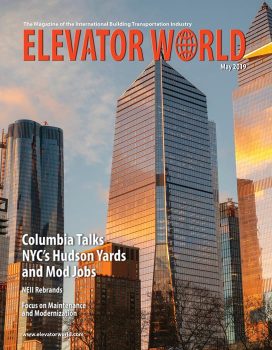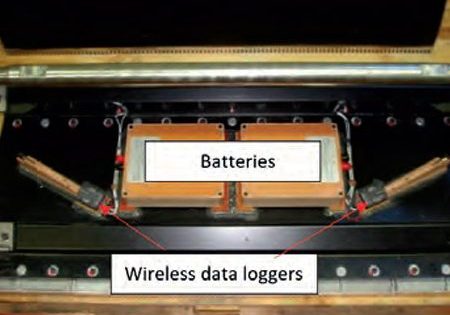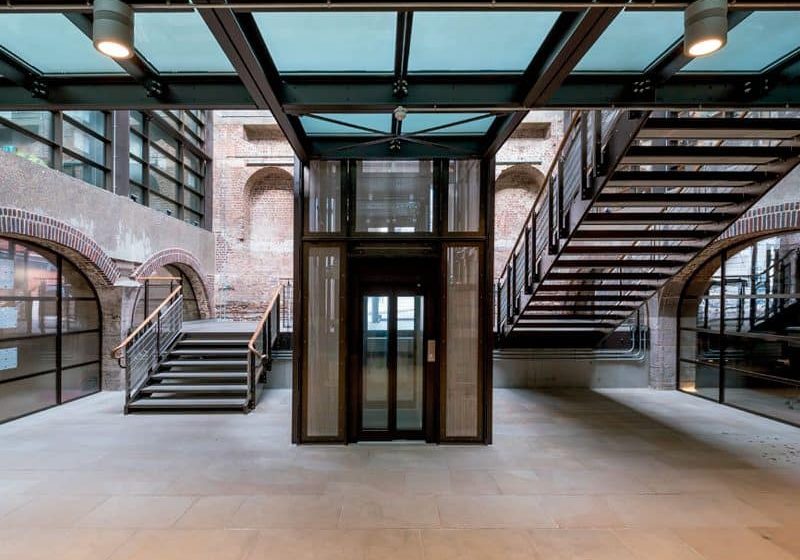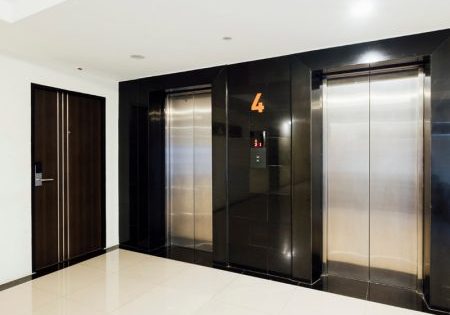A Crowning Achievement
May 1, 2019

ELMAS PoY win prompts a grand celebration at “Dracula’s Castle” in Romania.
Champagne, bottles of wine sporting an image of S.C. ELMAS SRL’s Project of the Year (PoY) trophy and the elevator system serving Bran Castle in Bran, Romania, recreated in miniature, in the form of an elaborate cake: part of a celebration on February 25 organized by the castle’s marketing teams and ELMAS that, for ELMAS General Manager Marton Geza Roth, represented the culmination of a long, sometimes difficult, journey. Taking place on a sunny, chilly day, the event served as confirmation of ELMAS as a survivor and accomplished innovator, a way to thank the myriad people and entities involved, and, perhaps most importantly, provide Roth the opportunity to tell the company’s story. ELMAS earned ELEVATOR WORLD’s top project award this year in the Special-Purpose Lifts category for its Stone Elevator, a key part of the Time Tunnel, which tells the story of the 14th-century stone fortress — one of several linked to the Dracula legend[1] — through pictures and interactive displays.
Featuring speeches from Roth; Bülent Yılmaz, managing director, EW Turkey and Middle East; and Lia Doru-Trandafir, Bran Castle administrator, the grand affair drew approximately 70 guests to the castle for an elegant dinner. It was covered by local and national news.
In his speech, Roth walked the crowd back through the history that led to the company’s current success. He described visiting the machine room and hoistway of a lift in the Czech village of Braşov in 1970 while he was on a job hunt. He was fascinated by the electric hoist and machine-room equipment, so he decided to pursue a career in vertical transportation.
He went to work for a local elevator repair and maintenance company, explaining that, prior to the revolution in 1989 through which Romania gained independence after 42 years of Communist rule,[2] all of the nation’s lifts were manufactured exclusively in the capital city of Bucharest. But, he and 11 business associates were in the process of preparing themselves for a future that would be very different. In 1990, Romania’s first year of democracy, Roth and his associates founded ELMAS, an acronym for “electromechanics of elevators.” Roth says he and his team felt confident about their new business venture and were resolved to take it seriously:
“Vertical transportation of persons involves a great responsibility on the part of those who design, build, install and maintain the equipment. In this area, errors or improvisation can lead to serious accidents. The basics, but also many secrets of this profession, we received from some of the specialists and inspectors of state bodies prior to the revolution. To our joy, some of them, such as engineers Badea Ion and Sezonov Mara, are here with us today. I am sure they enjoy this success with us, as they helped guide us in building and evolving our company.”
Roth said the first years were fraught with obstacles and frustrations, but that, because company employees were also its owners, ELMAS withstood the test of time. It is because of the company’s dedicated and talented employees, he said, that achievements such as the PoY award are possible. “I would like to thank all my associates, some of whom are here today, for the tenacity in believing in our dream,” Roth said. “This performance was only possible with the collective effort of all 420 employees of the company. Today is the basis of our future success.”
ELMAS is headquartered in central Romania in the city of Braşov, a large commercial hub with a population of approximately 253,200. It is surrounded by the Southern Carpathian mountains and is part of the historical region of Transylvania.[3]
Initially focusing on repair and installation, the company manufactured its first elevator in 1996. For 13 years, ELMAS produced what could be described as typical lifts for typical buildings. The economic crisis of 2008 changed the rules of the game, Roth said. It ended up having a silver lining, however, since it put ELMAS on a path that has turned it into a specialist that stands out among its peers.
“We had to reorient ourselves to less-covered areas, such as the design and construction of special-purpose lifts,” he said. This was no easy road, involving:
- Thorough training of design engineers and installers
- Investment in production capacity
- Procurement of design and activity-tracking software
- Achieving of International Organization for Standardization certification
- Setting up the company’s own testing laboratory and obtaining all necessary related certifications
Laying a solid foundation in the fi rst years aft er the revolution, ELMAS hired a pair of engineers with a wealth of experience who worked for a large company: Candea Aurel (unable to attend due to health reasons) and Mihai Centea, who was present. Aurel and Centea were key in developing ELMAS’ “vital, new design department,” Roth said.
The pair joined forces with Transilvania University of Braşov, bringing graduate engineering students onto the team. Th e students tackled their jobs with “the same dedication and earnestness” of the senior engineers in developing the department. Roth went on to say:
“I would like to thank another engineer, Ioan Racoceanu, one of the most experienced experts in lift installations in our country, for the technical support he has given our young engineers, as well as P.Eng. Radu Iovanas fr om Transilvania University for his guidance in welding technique that allowed the specialization of young welding engineers in our company. Our award will certainly bring joy to these specialists.”
As it grew, the company established a testing laboratory and a Department of Quality Assurance, which Roth said “has become a well-structured, highly performing department that has a significant impact on our work.” Collaboration with Romanian specialists in various fi elds helped build the department, he added.
Special-purpose lift s are not ELMAS’ only area of expertise. In 2010, the company began a partnership with Japan’s Mitsubishi Electric that allows it to provide high-speed, high-rise elevators. Previously not available in Braşov, these products contributed to enhancing the skill and professionalism of ELMAS fi tters and technicians, Roth said.
The idea to hold a party to celebrate the Stone Elevator’s honor from EW came to ELMAS leaders’ and castle administrators’ minds as soon as they received the letter informing them of the win. In addition to a celebration, it was a day of saying “thank you” to numerous parties, including architects Andrei and Oana Mihăilescu; Roncea Cristinel, technical engineer and representative of the Romanian certifi cation body SRAC; representatives of the National Co. for Boiler Control, Lift ing Equipment and Pressure Vessels SA; representatives of State Inspection for Boiler Control, Pressure Vessels and Lift ing Installations; and the Bran Castle Board, which includes the castle’s owner, Archduke Dominic von Habsburg, and Trandafi r, and which off ered ELMAS the Stone Elevator contract in the fi rst place.
The story of the von Habsburg family is dramatic. In a way, it reflects the past trials and solid future of ELMAS. Bran Castle, the home where the archduke grew up, was appropriated by the Communists in 1948.[4] It was legally returned to the family approximately a decade ago. Today, it is one of Romania’s top tourist destinations and is considered one of the world’s 10 most prestigious real-estate properties.[1]
Trandafir said:
“We are honored that, this year, the 10th anniversary of the return of the castle to the heirs of law, we can celebrate together the professionalism of the Romanian partners involved in the Time Tunnel project. Th is award won by ELMAS demonstrates how special the Bran Castle is.”
References
[1] en.wikipedia.org/wiki/Bran_Castle
[2] en.wikipedia.org/wiki/Romanian_Revolution
[3] en.wikipedia.org/wiki/Bra%C8%99ov
[4] en.wikipedia.org/wiki/Dominic_von_Habsburg
Get more of Elevator World. Sign up for our free e-newsletter.









